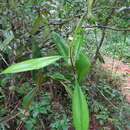pt-BR
nomes no trilho de navegação


Nepenthes distillatoria ya iku sawijining tetuwuhan tropis kang asalé saka Sri Lanka. Tetuwuhan iki kalebu tetuwuhan kang mangan kewan gegremetan (karnivora). Ing pérangan tetuwuhan iki ana kantong kang isiné jebakan kanggo kewan gegremetan. Kèwan gegremetan tiba ing jeroné kantong banjur dipangan déning tetuwuhan iki. Ing pérangan ngisor kantong ana cuèran kang duwé piguna kaanggo ngremuk lan maamah kèwan gegremetan. Miturut IUCN, status konservasi tetuwuhan iki kalebu mutawatiri.[15]
Habitat saka Nepenthes distillatoria ya iku dhataran asor kang dhuwuré 0 - 700 mèter sadhuwuré mandaya. Lumrahé tetuwuhan iki ditemoni ing lemah kang teles lan ngisoré awujud wedhi. Tetuwuhan iki bisa ditemoni ing sakpinggiré dalan, papan kang tinarbuka, lan ing alas. Ing donya iki, tetuwuhaan iki bisa ditemoni ing antarané Asia wétan nganti Sri Lanka.[15]
Tetuwuhan iki thukul ing iklim tropis kang teles. Kahanan kang apik dhéwé supaya tetuwuhan iki thukul ya iku kahanan kang lembab, kanthi suhu ora asor saka 18°C ing usum adhem lan 38°C ing usum panas.[16] Tetuwuhan iki bisa urip ing usum adhem nalika duwéni kalembaban kang cukup. Tetuwuhan iki ora diprayogakaké dipernahké ing omah kaca, amarga bisa kepanasen lan bisa ganggu anggoné thukul. Kultivasi tetuwuhan iki ora nganggo pot kang gedhé, cukup nganggo pot kang cilik kanthi disirami banyu kang ajeg. Tetuwuhan iki ditandur ing pot kanthi diamèter 6 in menawa dawa pangé 10 ft, duwéni kantong kang gedhé, lan durung ditandur ing pot 3 taun. Menawa tetuwuhan kang duwé pang dawané 30 ft dipernahaké ing pot kanthi diamèter 12 in. Nalika ditandur ing pot, lemah kang apik ya iku jinis gambut soklat kang dicampur karo wedhi. Supaya oyod tetuwuhan iki tetep seger, ing sakiwa tengené tetuwuhan ditanduri tetuwuhan jinis paku, kaya ta Adiantum cuneatum.[17]
Ing Sri Lanka tetuwuhan iki diarani tetuwuhan serat kang piguna dhéwé. Kang digunakaké kanggo seraat saka tetuwuhan iki ya iku gagangé. Gagangé duwé sipat kang lentur lan kuwat. Wiwitané tetuwuhan iki dikumpulaké saka alas, banjur digawé barang-barang kang piguna kanggo padinan, kaya ta digawé tali, kranjang, lan gagang porong. Kanggo babagan omah-omahan tetuwuhan iki bisa digawé pager, gedhèk, lan atep.[15]
Saliyané gagangé, tetuwuhan iki dijupuk cuéran kang manggon ing ngisor kantong. Cuéran iku ngandut ènzim pencernaan ya iku nepenthesin I lan nepenthesin II kang aktif ing pH 2,3. Ènzim bisa kanggo obat lara HIV lan AIDS. Ènzim tetuwuhan iki padha wigatiné kaya ènzim pencernaan pepsin.[15] Godong lan oyot tetuwuhan iki bisa digunakaké kanggo obat mumet, diabetes insipidus, lan dispasia. Nutrisi kang kaandhut ing tetuwuhan iki ya iku uyah, asam sulfat, alkaloid, resin, lan alkohol. Mula tetuwuhan iki efektif kanggo tonik, laktasik, oksitosik, diuretik, lan lara weteng.[18]
Nepenthes distillatoria ya iku sawijining tetuwuhan tropis kang asalé saka Sri Lanka. Tetuwuhan iki kalebu tetuwuhan kang mangan kewan gegremetan (karnivora). Ing pérangan tetuwuhan iki ana kantong kang isiné jebakan kanggo kewan gegremetan. Kèwan gegremetan tiba ing jeroné kantong banjur dipangan déning tetuwuhan iki. Ing pérangan ngisor kantong ana cuèran kang duwé piguna kaanggo ngremuk lan maamah kèwan gegremetan. Miturut IUCN, status konservasi tetuwuhan iki kalebu mutawatiri.
Nepenthes distillatoria (/nɪˈpɛnθiːz dɪˌstɪləˈtɔːriə/; Neo-Latin, from Latin: destillo "to distill", -oria, adjectival ending; "something from which a liquid is distilled", i.e., pitcher) is a tropical pitcher plant endemic to Sri Lanka. It was the second Nepenthes species to be described in print and the first to be formally named under the Linnaean system of taxonomy. It is therefore the type species of the genus.
Nepenthes distillatoria was the second Nepenthes species to be described in print, after N. madagascariensis. In 1677, Danish physician Thomas Bartholin made brief mention of it under the name Miranda herba, Latin for "marvellous herb".[13] Three years later, Dutch merchant Jacob Breyne referred to this species as Bandura zingalensium, after a local name for the plant.[12] Bandura subsequently became the most commonly used name for the tropical pitcher plants, until Linnaeus coined Nepenthes in 1737.[15]
Nepenthes distillatoria was again described in 1683, this time by Swedish physician and naturalist Herman Niklas Grim.[14] Grim called it Planta mirabilis destillatoria, or the "miraculous distilling plant", and was the first to clearly illustrate a tropical pitcher plant.[15] Three years later, in 1686, English naturalist John Ray quoted Grim as saying:[10]
The root draws up moisture from the earth which with the help of the sun's rays rises up into the plant itself and then flows down through the stems and nerves of the leaves into the natural utensil to be stored there until used for human needs. [translated from Latin in Pitcher-Plants of Borneo][15]
Linnaeus used Grim's original specific epithet when naming N. distillatoria in 1753.
Nepenthes distillatoria was again illustrated in Johannes Burmann's Thesaurus Zeylanicus of 1737. The drawing depicts the end of a flowering stem with pitchers. Burmann refers to the plant as Bandura zeylanica.[11]
In the horticultural trade of the late 19th century, N. distillatoria was often confused with N. khasiana of India.[17][18][19][20]
Nepenthes distillatoria is endemic to Sri Lanka and is the only Nepenthes species recorded from the island. It grows in waterlogged open scrub, along road embankments and other cleared areas, and in forest. N. distillatoria occurs from sea level to 700 m altitude.[1]
Due to its isolation, N. distillatoria has no known natural hybrids.
Three infraspecific taxa of N. distillatoria have been described, although they are no longer considered valid.
Nepenthes distillatoria (/nɪˈpɛnθiːz dɪˌstɪləˈtɔːriə/; Neo-Latin, from Latin: destillo "to distill", -oria, adjectival ending; "something from which a liquid is distilled", i.e., pitcher) is a tropical pitcher plant endemic to Sri Lanka. It was the second Nepenthes species to be described in print and the first to be formally named under the Linnaean system of taxonomy. It is therefore the type species of the genus.
Nepenthes distillatoria L., 1753 è una pianta carnivora della famiglia Nepenthaceae[2], endemica dello Sri Lanka, dove cresce a 0–700 m.
La Lista rossa IUCN classifica Nepenthes distillatoria come specie vulnerabile.[1]
Nepenthes distillatoria L., 1753 è una pianta carnivora della famiglia Nepenthaceae, endemica dello Sri Lanka, dove cresce a 0–700 m.